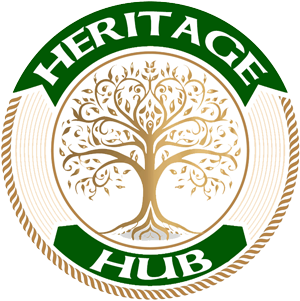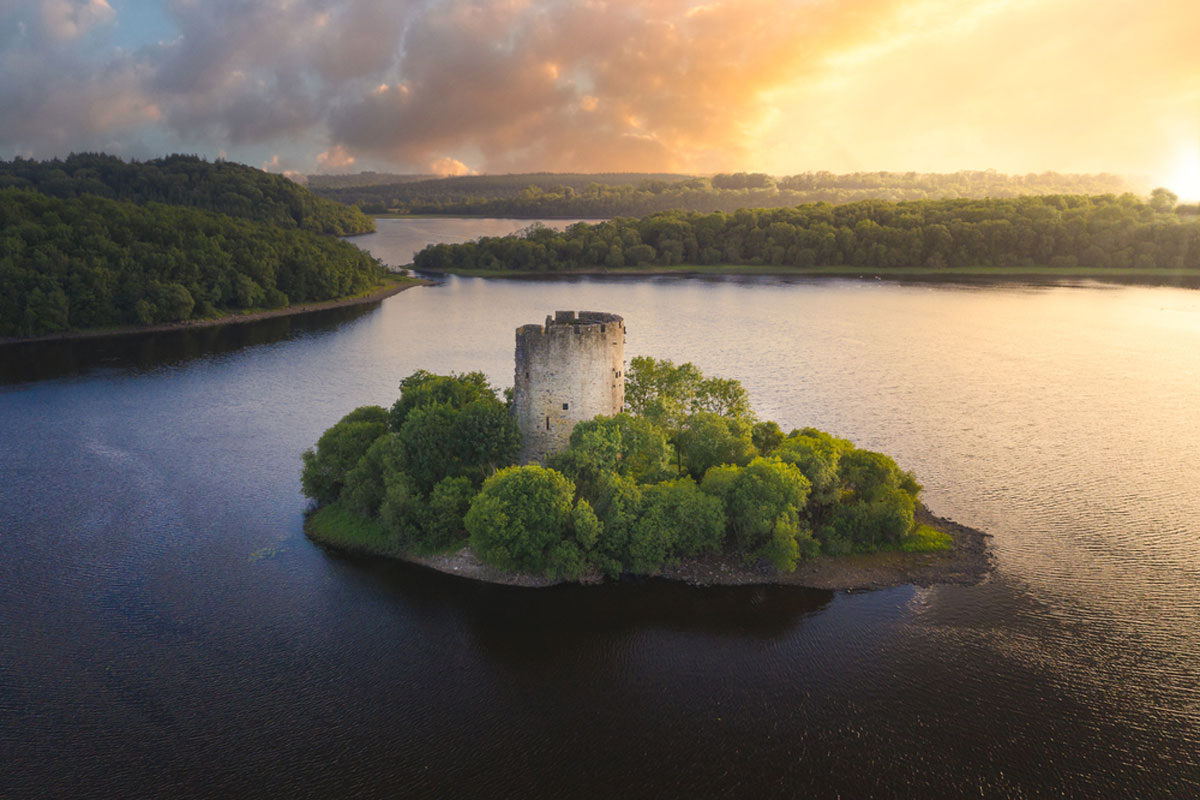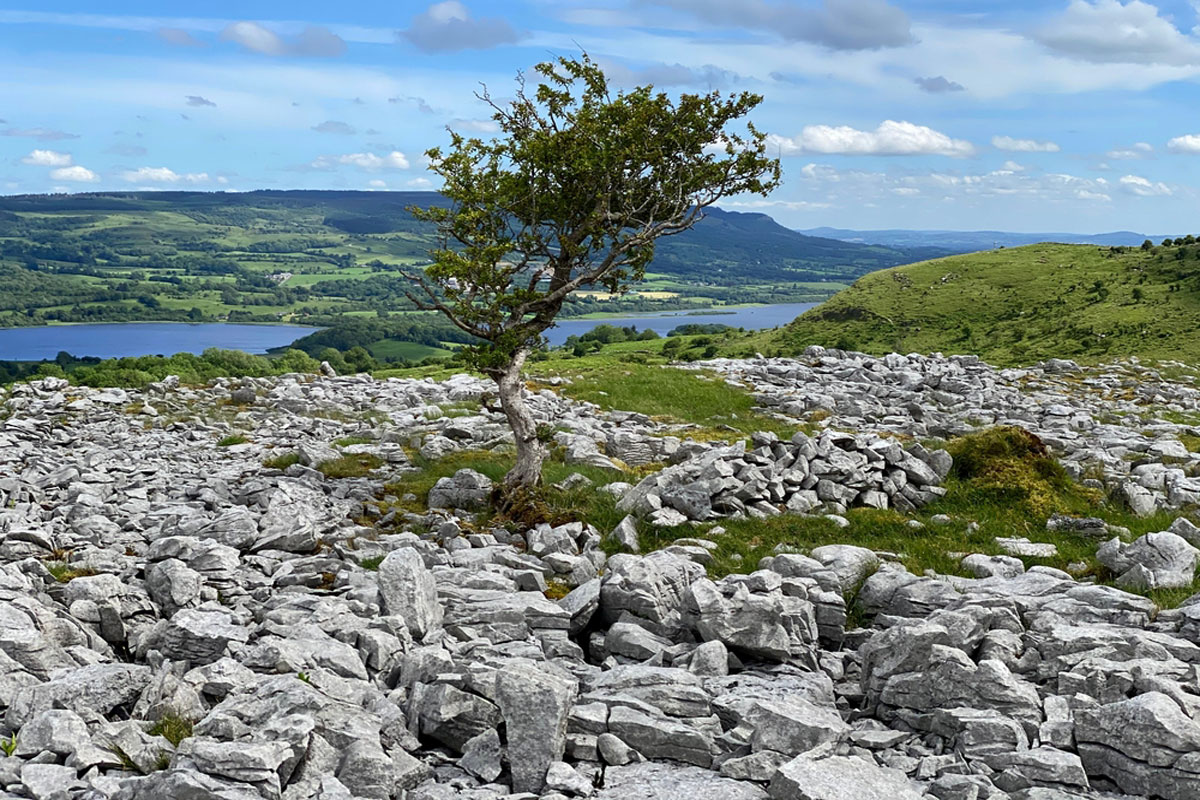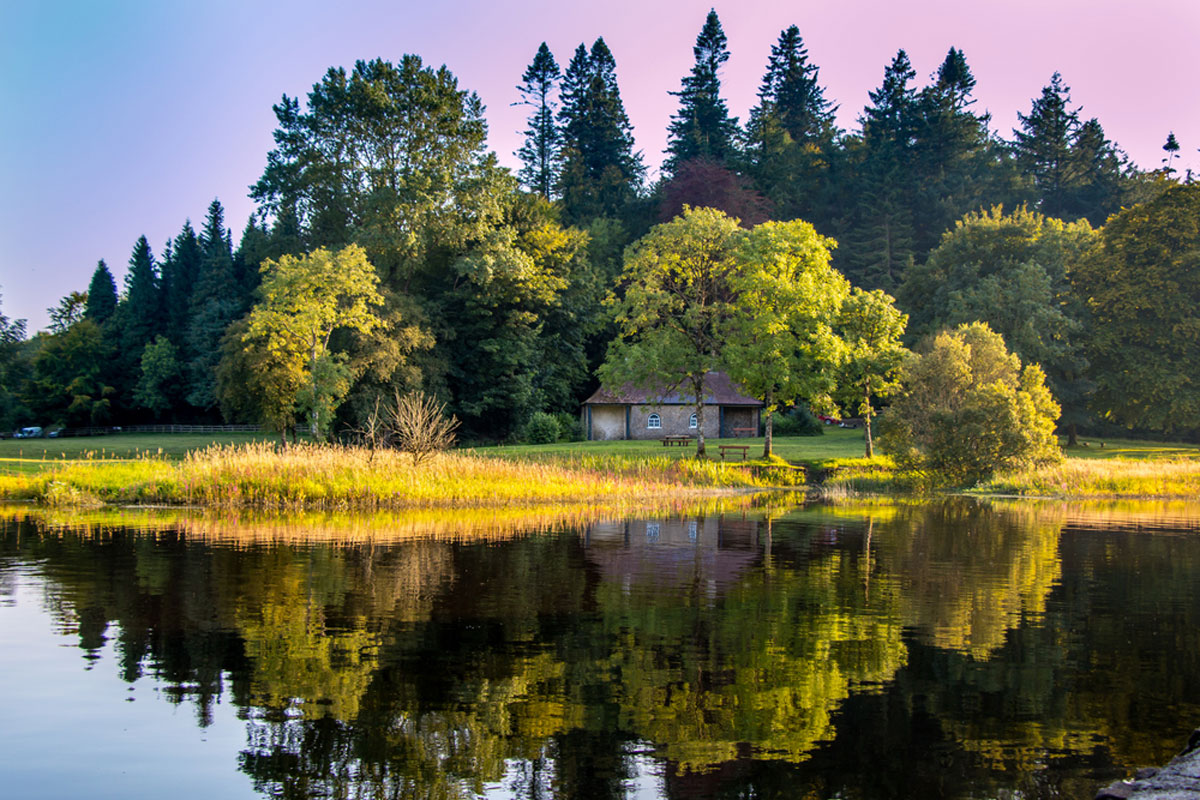Introduction to Lough Oughter and Clough Oughter Castle
Nestled in the heart of County Cavan, Lough Oughter is a breathtaking lake system known for its tranquil beauty, rich wildlife, and historical significance. Among its many charms, the most iconic feature is Clough Oughter Castle, a 13th-century Norman stronghold situated on a small island in the middle of the lake.
This picturesque ruin stands as a testament to Ireland’s medieval past, with its circular tower reflecting in the waters—a scene that captivates visitors, photographers, and history enthusiasts alike. Whether viewed from the shore or explored by boat or kayak, Clough Oughter Castle remains one of Ireland’s most enchanting historical sites.
1. The Enchanting Beauty of Lough Oughter
Lough Oughter is part of the larger Erne River system, a maze of lakes, inlets, and wetlands that create an idyllic setting for nature lovers.
- The lake is home to a diverse range of wildlife, including swans, herons, otters, and kingfishers.
- Anglers are drawn to the waters for its excellent stocks of pike, perch, and bream.
- The calm waters make it a perfect spot for kayaking and canoeing, with the castle as the ultimate destination.
With its unspoiled landscapes and serene waters, Lough Oughter offers a sense of peace and isolation, making it a haven for adventurers and those seeking quiet reflection.
2. A Castle Steeped in History
Clough Oughter Castle is not just a stunning ruin; it has a long and storied past, dating back to the early 13th century. Originally built by the Normans, the castle later became a stronghold of the O’Reilly clan, rulers of East Breifne (modern-day Cavan). Over the centuries, it witnessed battles, sieges, and shifting power struggles, ultimately falling into ruin but retaining its mystique and historical significance.
The History of Clough Oughter Castle – A Stronghold of Power and Conflict
Clough Oughter Castle, standing on a small island in Lough Oughter, is not just a beautiful ruin—it is a monument to centuries of Irish history. Built in the early 13th century, the castle played a crucial role in Norman expansion, Gaelic resistance, and later wars that shaped Ireland’s history.
1. Norman Beginnings and Gaelic Resistance
The castle’s origins date back to the Anglo-Norman invasion of Ireland, when the Normans sought to expand their control over the island.
- Built around 1220, Clough Oughter Castle was part of a series of fortifications constructed by the Norman De Lacy family to establish dominance over Breifne (modern-day Cavan and Leitrim).
- However, the Normans never fully subdued the region, and by the mid-13th century, the O’Reilly clan—the Gaelic rulers of East Breifne—seized the castle.
- Under the O’Reillys, Clough Oughter Castle became a stronghold of Irish resistance against Norman and later English influence.
2. A Fortress of the O’Reilly Clan
For over three centuries, the O’Reillys ruled from Clough Oughter, using it as a symbol of their power.
- The castle’s island location made it nearly impenetrable, providing a strategic advantage in times of conflict.
- During the late medieval period, the O’Reillys used the castle both as a defensive fortress and a prison, holding captured enemies and political rivals.
The O’Reillys remained dominant until the late 16th century, when English forces began asserting greater control over Ireland. This marked the beginning of the castle’s most turbulent years.
3. The 17th Century – Clough Oughter in the Irish Confederate Wars
The early 1600s saw Ireland caught in a series of rebellions and wars, with Clough Oughter Castle at the center of the action.
- In 1641, during the Irish Rebellion, the castle was used as a prison for English settlers after Irish forces seized control.
- In 1653, near the end of the Cromwellian Conquest of Ireland, the castle came under siege by English Parliamentarian forces led by Colonel Venables.
- After a heavy bombardment, Clough Oughter Castle surrendered—marking the end of its role as a military stronghold.
The castle was never fully restored after this siege, leaving it in ruins. However, its circular tower and stone walls remain standing, preserving the memory of its storied past.
The Architecture and Defensive Features of Clough Oughter Castle
Clough Oughter Castle’s circular design, strategic island location, and sturdy stone walls made it a formidable medieval fortress. Despite standing in ruins today, its architecture reveals much about its Norman origins and later Gaelic modifications.
1. A Unique Circular Keep
Unlike many other castles in Ireland, which feature square or rectangular keeps, Clough Oughter Castle is entirely circular. This design was likely influenced by Norman military engineering, offering several advantages:
- Defensive Strength: Rounded walls deflected projectiles better than flat surfaces, making sieges more difficult.
- Minimized Blind Spots: The lack of corners reduced the ability for attackers to take cover or undermine the structure.
- Structural Integrity: The circular shape allowed for even weight distribution, making it more resistant to collapse.
Historians believe that the original Norman builders introduced this cutting-edge design, which was later enhanced by the O’Reillys to withstand repeated conflicts.
2. Thick Stone Walls and Limited Access Points
Clough Oughter Castle’s stone walls—built using locally sourced limestone—were exceptionally thick, providing:
- Strong protection against arrows, battering rams, and cannon fire.
- Insulation against harsh weather conditions, making it livable for long periods.
- A solid foundation to support its multi-level interior, including living quarters, storage rooms, and a great hall.
The castle had only one known entrance, further increasing its defensive capabilities. Access to the keep was likely via a wooden staircase that could be removed in case of attack.
3. Strategic Island Location
Perhaps Clough Oughter Castle’s greatest defense was its position on an island in Lough Oughter:
- Natural Moat: The surrounding lake made it nearly impossible for enemies to storm the castle without boats.
- Restricted Access: Attackers had to cross the water under enemy fire, making sieges extremely difficult.
- Escape Route: The O’Reillys and their allies could use boats to retreat into the lake’s maze-like waterways, confusing invaders.
Even during the Cromwellian siege in 1653, it took sustained cannon bombardment from the shoreline to force the defenders to surrender—evidence of the castle’s impressive resilience.
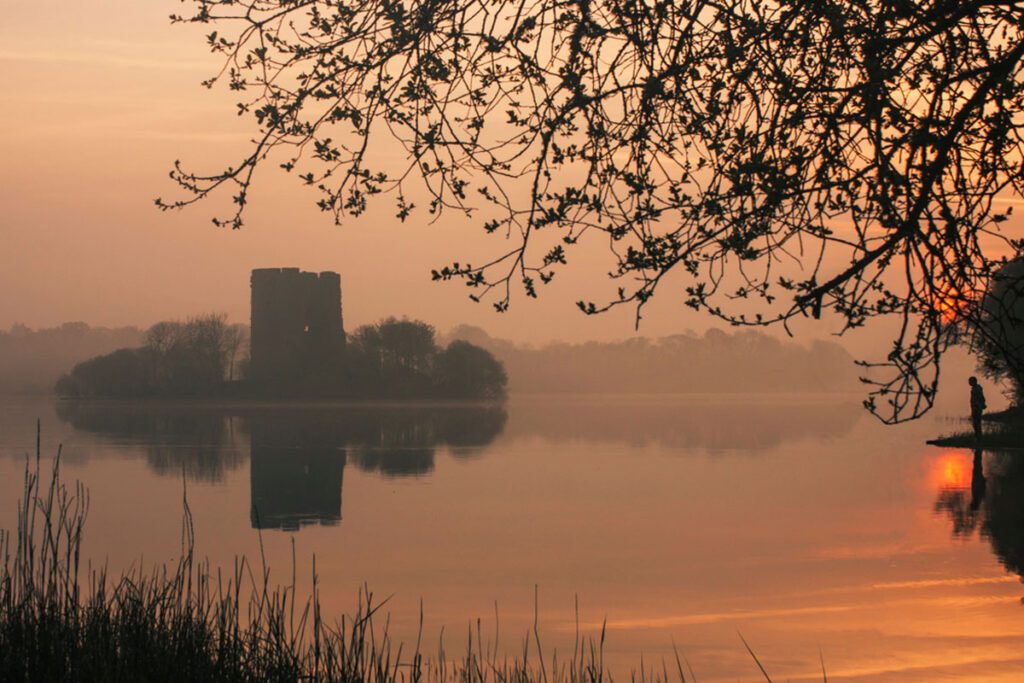
Clough Oughter Castle Today – Conservation and Tourism
Despite its centuries-old ruins, Clough Oughter Castle remains a fascinating landmark, attracting visitors, historians, and nature enthusiasts alike. The castle and its surroundings are now part of a protected heritage site, with efforts to preserve its structure and promote eco-friendly tourism.
1. Conservation Efforts and Preservation
Recognizing the castle’s historical and cultural importance, conservation projects have been undertaken to protect and stabilize its ruins.
- Archaeological studies have helped document the site’s history, revealing insights into medieval life and warfare.
- Structural reinforcements have been added to prevent further collapse of the remaining walls.
- Local heritage organizations work to maintain the castle as part of Ireland’s national heritage, ensuring it remains accessible to future generations.
While no full restoration is planned, the goal is to preserve the castle in its current state, allowing visitors to experience its authentic medieval character.
2. A Unique Tourist Experience
Clough Oughter Castle is one of Ireland’s most unique historical attractions, due to its island location and unspoiled surroundings. Visitors can explore the site in an adventurous and immersive way.
- Boat and Kayak Tours: The most popular way to visit is by canoeing or kayaking across Lough Oughter. Guided tours provide insights into the castle’s history, legends, and wildlife.
- Photography and Sightseeing: The castle’s reflection in the water makes it a stunning subject for photographers, especially at sunrise or sunset.
- Wildlife and Nature Walks: The lake and its islands are home to a variety of bird species, otters, and other wildlife, making it a great spot for birdwatching and eco-tourism.
Since Clough Oughter is a protected site, visitors are encouraged to explore it responsibly, ensuring the area’s natural and historical integrity is maintained.
3. Local Attractions and Activities
A trip to Clough Oughter Castle can be combined with other activities in County Cavan, a region known for its lakes, forests, and rich history.
- Killykeen Forest Park – A beautiful woodland area near Lough Oughter, perfect for hiking, cycling, and picnicking.
- Cavan Burren Park – A prehistoric landscape filled with megalithic tombs, limestone formations, and scenic trails.
- The Cavan Genealogy Centre – A great stop for those researching Irish ancestry, especially if they have connections to the O’Reilly clan.
These attractions, combined with the peaceful ambiance of Lough Oughter, make the area a hidden gem for history lovers and outdoor adventurers alike.
Myths, Legends, and Folklore of Clough Oughter Castle
Like many ancient Irish castles, Clough Oughter Castle is steeped in legends and folklore, adding to its mystique and allure. Over the centuries, tales of ghostly spirits, heroic battles, and hidden treasures have been woven into its history, making it more than just a ruin—it is a place of stories and secrets.
1. The Ghosts of Clough Oughter
Many locals and visitors have reported strange occurrences near the castle, leading to rumors of hauntings.
- It is said that the spirits of imprisoned rebels and political prisoners still linger within the ruined walls. Some claim to have heard whispers and faint cries echoing across the lake at night.
- A particularly chilling legend tells of a former prisoner who was executed on the island, whose restless spirit still guards the castle, seeking vengeance against those who wronged him.
- Fishermen on Lough Oughter have spoken of mysterious lights flickering around the castle on foggy nights, with no apparent source.
Whether real or imagined, these ghostly tales contribute to the castle’s mysterious and haunting beauty.
2. The Legend of the Hidden Treasure
One of the most enduring myths surrounding Clough Oughter Castle is the story of buried treasure.
- According to folklore, when the castle was besieged by Cromwellian forces in 1653, the defenders hid a great hoard of gold and silver somewhere within the island or the lake’s waters.
- Some believe the treasure was never recovered and still lies buried beneath the ruins or in the depths of Lough Oughter.
- Over the years, many have attempted to find the lost riches, but none have succeeded—adding to the castle’s mystery and intrigue.
Could there still be ancient relics or hidden fortunes waiting to be discovered? The legend continues to spark curiosity and adventure.
3. The Castle’s Role in Irish Heroic Tales
Clough Oughter Castle has also been linked to Irish heroism and defiance, particularly in times of war and rebellion.
- As the stronghold of the O’Reilly clan, it became a symbol of Irish resistance against foreign rule.
- Stories tell of brave warriors who fought to defend the castle, refusing to surrender even as enemy forces closed in.
- One tale speaks of an O’Reilly chieftain who, rather than be captured, chose to perish in battle, his spirit forever guarding the castle and his people’s legacy.
These legends keep Clough Oughter Castle alive in the hearts of those who cherish Ireland’s rich and storied past.
Conclusion: A Place of History, Mystery, and Beauty
Clough Oughter Castle is more than just a medieval ruin—it is a place of historical significance, breathtaking scenery, and captivating folklore. Whether you visit for its tranquil lake setting, architectural beauty, or intriguing myths, the castle leaves an unforgettable impression.
Today, as it stands in the still waters of Lough Oughter, the castle remains a silent storyteller, whispering the tales of knights, rebels, and lost treasures to those who take the time to listen.
Final Thought: Your Next Adventure Awaits
Whether you’re kayaking to its shores, capturing its beauty through photography, or simply immersing yourself in its history, Clough Oughter Castle offers a journey into Ireland’s medieval past and mythical world.
Natural Attractions
- Cavan Burren Park – A stunning geopark with ancient megalithic tombs, fascinating rock formations, and walking trails.
- Lough Oughter and Clough Oughter Castle – A picturesque lake and a ruined 13th-century castle on an island.
- Shannon Pot – The source of the River Shannon, surrounded by beautiful countryside.
- Killykeen Forest Park – A tranquil park with forest trails, lake views, and picnic areas.
- Dún na Rí Forest Park – Known for its romantic glades, scenic walks, and historical ruins.
Historical and Cultural Sites
- Cavan County Museum – Showcasing Cavan’s history, including an immersive World War I trench exhibit.
- Drumlane Monastic Site – The ruins of a 6th-century monastery with a round tower and stunning views.
- Belturbet Railway Station Visitor Centre – A restored railway station offering a glimpse into Cavan’s transport history.
- Farnham Estate – A historic estate with walking trails and a luxurious spa.
Lakes and Water Activities
- Lough Sheelin – A paradise for anglers, known for its trout fishing.
- Lough Ramor – Popular for boating, fishing, and lakeside picnics.
- The Cavan Lakes – A network of over 365 lakes, perfect for kayaking, fishing, and birdwatching.
Scenic Drives and Villages
- The Marble Arch Caves Global Geopark – Spanning Cavan and Fermanagh, featuring caves, waterfalls, and stunning landscapes.
- Cootehill – A charming market town with historical landmarks and access to Dartrey Forest.
- Ballyjamesduff – Home to the Percy French Museum, celebrating the life of the famous songwriter.
Unique Experiences
- Cavan Adventure Centre – Offering activities like kayaking, paddleboarding, and team-building challenges.
- Erica’s Fairy Forest – A magical fairy trail in Cootehill dedicated to a young girl’s memory.
- Slieve Russell Golf and Country Club – A luxury resort with a championship golf course and stunning grounds.
County Cavan is a haven for nature enthusiasts, history buffs, and those looking to unwind in a peaceful rural setting.
Helpful Resources


